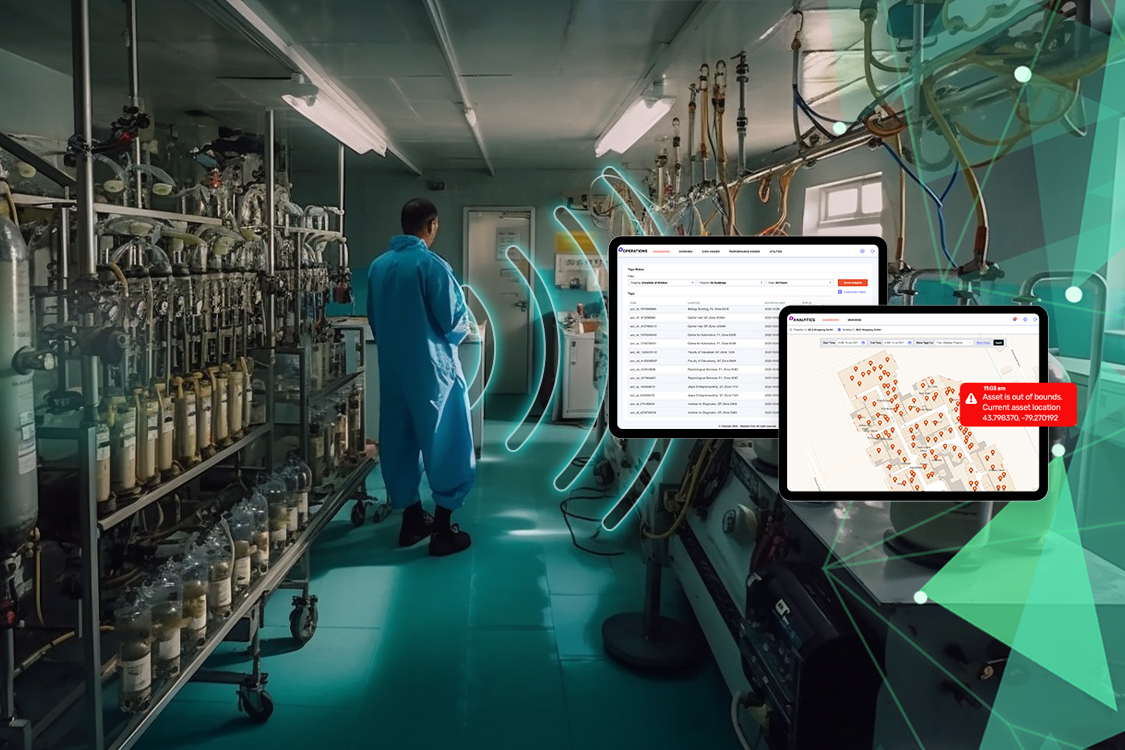IoT Solutions

Anything hospital administrators can do to make life better for patients and staff in hospitals bears looking into. In this age of burgeoning technology, there are digital solutions available, one of which includes indoor asset tracking for hospitals using Internet of Things (IoT) asset tracking software.
For those who aren’t familiar with IoT, let’s explain it a bit. In a nutshell, IoT is a network of physical objects with sensors, software and other technologies to connect and exchange data with other devices and systems using the internet. More than 10 billion people connect with IoT devices today and experts expect that number to grow to 22 billion by 2025.
Via low-cost computing, the cloud, big data, analytics and mobile technologies, physical things can share and collect data with minimal human intervention. Digital systems can now record, monitor and adjust each interaction between connected things. It’s a marriage of cooperation and communication between the physical world and the digital world.


Research and consulting firm, Fact.MR, stipulates in 2023 that global demand for hospital asset management stands at a market value of about US$14.5 billion and expects that growth to continue. In fact, the market is expected to reach about US$69 billion by the end of 2033 – that’s an incredible 16.8% compound annual growth rate (CAGR) in one decade.
Asset Tracking in Healthcare
Using an indoor medical equipment asset tracking tool, healthcare providers can pinpoint the whereabouts of critical and non-critical assets. These can include such things as beds, wheelchairs, IV pumps and biometric monitors. Tracking can also include patients and staff and the system is particularly important for elderly patients who may wander away and can be found quickly using real-time tracking.
Tracking can also provide information regarding patterns of use and when equipment is not in use to ascertain when equipment is being under or over-utilized. Pertinent information can include:
- Equipment service schedules
- Equipment wait times
- Length of time assets are in storage
- How much time staff members spend looking for assets
Efficient Operations and Accurate Procedures
When hospitals can save time searching for equipment or people, it also means they can save money. Locating assets easily in a hospital is crucial. Knowing the locations of things, patients and staff means care can happen more quickly. Analytics indoor asset tracking solutions provide information on the use of assets and where they’re located. This aids in the optimization of assets and reduces the costs of replacing or leasing equipment.
Staff can see if equipment has been properly kept and used to the fullest based on the data they can view. A system like Mapsted’s can also provide information on if a piece of equipment has been removed from the premises or stolen.
Having the right equipment in the right place at the right time allows professionals to heighten procedural accuracy since they don’t have to rush or reschedule tests or procedures or compromise delivery of care due to issues locating certain medical equipment when the need arises.
Time is Money
Documentation shows that nurses spend more than an hour every day looking for something or someone. If they didn’t have to do that, they would be able to spend that time looking after patients. Equipment that can’t be found can’t be used. Hospitals spend millions of dollars every year replacing misplaced or stolen medical equipment such as wheelchairs.
Keeping track of assets means things can also be serviced regularly, which can save untold amounts of replacing equipment.
Merits of an Indoor Asset Tracking System
Asset tracking can reduce the amount of lost or missing equipment, improve hospital workflows and reduce operating costs.
With Mapsted’s innovative Asset Tracking Tag Series, some things hospitals can do include the following:
- Tagged medical and non-medical equipment for quick location, security against theft and to ensure regular maintenance
- Freeing nurses’ time so they can use that time to care for patients
- Locating personnel quickly, especially in emergencies
- Reducing costs of replacing equipment staff cannot find
- Providing increased security
- Scheduling regular maintenance on equipment so it’s ready for use
Predictive and Scheduled Maintenance
It’s not only important to be able to quickly track down equipment, but it’s necessary to ensure equipment is working properly.
Surgical tools and equipment are used regularly in hospitals and need to be sterilized frequently or they can cause infection in patients. Hospital asset tracking systems can help set up a maintenance schedule for all medical equipment and tools. Users can track maintenance schedules in real-time and get notified when repair sessions need to be scheduled. IoT solutions also help maintain and update tool records with the maintenance history of each tool through automated medical equipment tracking. Personnel can also assign specific maintenance instructions as recommended by the manufacturer to extend the life of the equipment.
Hospitals use state-of-the-art equipment, some of which can save or sustain human life. IoT devices can track how this equipment is performing, to avoid any issues due to outages or system failures. You can alert hospital staff if there’s a problem and complete any repairs before equipment fails. Not only is predictive maintenance more cost-effective, but it also keeps critical equipment, such as CT scanners, ventilators, etc. running at peak efficiency.
Improving Patient Care with IoT Asset Tracking
IoT-powered hospital equipment tracking systems enhance hospital workflows by ensuring that essential medical tools are always available when needed. Real-time tracking reduces delays, improves hospital efficiency and enhances patient care. By minimizing wait times and optimizing resource allocation, hospitals can improve treatment accuracy and patient outcomes.
Ensuring Compliance & Data Security in Asset Tracking
IoT healthcare asset tracking solutions help hospitals comply with strict regulations on medical equipment management. These systems integrate with hospital inventory software, ensuring real-time data tracking, automated reporting and secure asset management. This improves regulatory compliance and enhances overall hospital security.
The Bottom Line
Overall, IoT asset tracking for hospitals profoundly impacts asset management, workflow efficiency, patient safety and cost optimization. It empowers healthcare facilities to better utilize resources, improve patient outcomes and deliver high-quality care. Mapsted has some of the best indoor asset tracking software on the market today. This innovative technology works similarly to RFID but without the need for multiple RFID readers, which ultimately reduces installation and hardware costs. Only one Mapsted Boost device is required per 10,000 square feet to provide complete coverage of the area.
Give us an hour of your time and we can enlighten you further on how our asset tracking solutions can ramp up your hospital’s equipment optimization and save your time and money. We invite you to check out this blog, ways to improve the patient experience in hospitals, for more information on how our technology can help your hospital.
Frequently Asked Questions
Q1. What are the benefits of using IoT asset tracking in hospitals?
Ans. By harnessing the power of IoT asset tracking, hospitals can enhance asset management, improve operational efficiency, promote patient safety, achieve cost savings, and ensure compliance with regulatory requirements. It ultimately contributes to delivering high-quality patient care and optimizing hospital operations.
Q2. What types of assets can be tracked using an IoT system?
Ans. An IoT system can track various types of assets depending on the specific implementation and requirements. In the context of hospitals and healthcare facilities, some common assets that can be tracked using an IoT system include medical equipment such as infusion pumps, wheelchairs, defibrillators, ventilators, patient monitors, ultrasound machines, surgical tools and imaging equipment.
Q3. Can the IoT asset tracking system integrate with existing hospital infrastructure and software systems, such as inventory management or electronic health records?
Ans. IoT asset tracking systems can integrate with existing hospital infrastructure and software systems, including inventory management and electronic health records (EHR) systems. Integration allows for seamless data exchange, interoperability, and enhanced functionality across different systems.
Q4. What is the implementation process like? How long does it take to deploy the system and start tracking assets?
Ans. The timeline for implementing an IoT asset tracking system can vary widely depending on the complexity of the project, the size of the hospital, and the readiness of the infrastructure. It can range from a few weeks to several months. It is essential to work closely with the chosen solution provider to establish realistic timelines and milestones based on the specific requirements and constraints of the hospital.
Q5. Are there any specific compliance considerations to ensure the IoT asset tracking system aligns with healthcare regulations and standards?
Ans. There are specific compliance considerations that need to be addressed to ensure that an IoT asset tracking system aligns with healthcare regulations and standards. It is crucial to consult with legal and compliance teams within the healthcare organization to ensure the IoT asset tracking system meets the specific compliance requirements applicable to the region and industry. Compliance considerations should be integrated into the implementation and ongoing operation of the system ensuring a secure and compliant environment for asset tracking.
Q6: How does an IoT-based healthcare asset tracking system help with regulatory compliance?
A: An IoT healthcare asset tracking solutions ensure that hospitals meet compliance standards by maintaining detailed logs of medical equipment usage, maintenance schedules and asset locations. Automated tracking reduces errors and simplifies regulatory audits, ensuring healthcare facilities follow industry guidelines.
Q7: How do hospital equipment tracking systems improve patient safety?
A: A hospital equipment tracking system enhances patient safety by ensuring that medical devices, such as ventilators, infusion pumps and defibrillators, are always accessible and properly maintained. These systems prevent equipment shortages and reduce the risk of treatment delays during emergencies.
Q8: How can an IoT-based asset tracking system help reduce hospital costs?
A: An IoT asset tracking healthcare solution reduces hospital costs by preventing equipment loss, minimizing unnecessary purchases and optimizing resource allocation. By tracking real-time usage and maintenance needs, hospitals can extend the lifespan of medical equipment and improve overall financial efficiency.
Q9: What role does IoT play in hospital asset management IoT solutions?
A: Hospital asset management IoT solutions leverage IoT technology to track, monitor and manage medical equipment in real time. These systems enhance operational efficiency, reduce equipment downtime and improve hospital logistics by ensuring assets are always in the right place when needed.
Q10: How does equipment tracking in hospitals improve workflow efficiency?
A: Equipment tracking in hospitals eliminates time wasted searching for misplaced medical devices, allowing healthcare professionals to focus on patient care. By providing real-time asset location data, these systems improve hospital workflow, reduce inefficiencies and optimize resource utilization.
Q11: What is a hospital asset tracking system and how does it help prevent nurse burnout?
A: A hospital asset tracking system is a technology solution that uses real-time location tracking (RTLS), RFID or IoT to monitor and manage critical medical equipment, supplies and even staff within a healthcare facility. By ensuring that essential tools like ventilators, IV pumps and wheelchairs are readily available and easy to locate, nurses spend less time searching for equipment and more time focusing on patient care.
